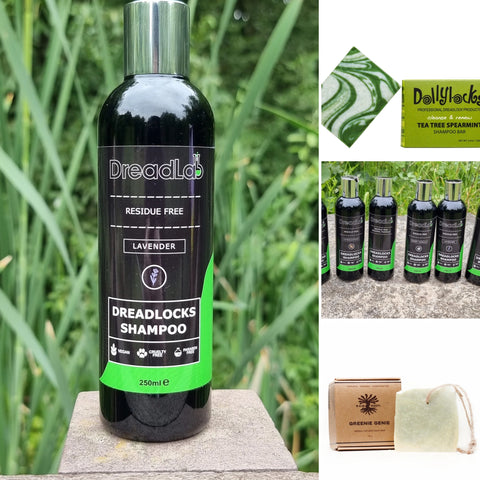New Dreadlocks Care
Welcome to the third part of the dreadlocks guide. In the previous articles we had a look at the techniques used to transform your hair into a gorgeous set of dreads, and now you may be wondering how you can take care of them. Newbies always have a lot of questions, so I'll try to answer the most common ones, thinking of both freeform and instant dreadlocks.

Photo by Concha Mayo on Unsplash
How often should I wash my dreads?
Often I hear the “rule” that new dreadlocks shouldn’t be washed for at least 3 weeks because they need time to settle. We even got to the point where people are not washing their hair at all, which is why dreads have the fame of being dirty. Whether we're speaking of freeform or instant dreads, washing them is considered a hurdle to their maturation. So let's debunk this myth: you should wash your hair as much as you need, and you should always keep your dreadlocks clean. Dirt and grease may make them look more compact, but in actuality it prevents them from dreading properly as it lubricates them. Clean hair on the other hand creates more friction, which is what we want for a speedy locking process.
However, especially with instant dreads, the advice of not washing them too much makes a lot of sense as massaging your hair and scalp could ruin some of the work you’ve done or have had done.
So the “not washing rule” has a valid root somewhere, but the way to go is in between: not washing too little and not washing too much. Depending on the climate you’re living in, and on how active your lifestyle is, you may need to wash your dreads every 3-4 days or every 7 days. When I’m in Italy I opt for a 3-4 days gap because it’s pretty hot, but here in the UK I can wait a bit longer. That said, keep in mind that everyone is different and you’ll find naturally, over time, the routine that works for you.

Photo by Hannah Xu on Unsplash
What shampoo should I use?
You’d be surprised to see how much difference the type of shampoo can make.
Regular shampoos are designed to strip off all of your natural sebum, which is a protective oily layer found all over your skin. Your scalp is then stimulated to produce more sebum faster, to restore that protective layer. This causes our head to become extra oily, and we’re compelled to shampoo again. This hooks us up to shampoo way more often than we need, and puts us at risk of developing dandruff because of the excess sebum.
For this reason it is crucial to use a good shampoo with quality ingredients. Switching to a dedicated dreadlocks shampoo will allow you to wash your hair less frequently, which is perfect for new dreads.
On this website you can find several shampoo brands, which are top quality and renowned worldwide. Some examples are Dollylocks, Raw Roots and Dreads UK. You can choose from plenty of liquid shampoos or shampoo bars, but remember to emulsify them first, to avoid product residue. For emulsifying, if using liquid shampoo, squirt a little amount on your hand and mix it with water. If using a bar, rub it between your hands and once they’re all soapy proceed to wash your dreads.

Visit the sections “Liquid Shampoo” and “Shampoo Bars” in the menu above
One last tip: start using dreadlocks shampoo before getting dreads to give your scalp time to adapt. It can take a few days, if not weeks, before your scalp naturally lowers the amount of sebum, allowing you to wash your hair less frequently.
How can I help my dreads mature?
For basic maintenance, your best bet is palm-rolling with occasional crocheting.
Ideally you’d palm-roll your dreads when they’re wet as this will encourage your hair to get more compact, help your loose hair to stay put and will flatten out potential lumps and bumps.
Crocheting is a game changer for achieving immediate results, so we totally recommend it. However we advise to not over do it as it can cause hair breakage, especially if you’re not a pro, which could lead to dreadlocks breakage in the long run. Plus, you could damage your scalp when pulling at the roots with too much enthusiasm. So, do crochet your hair but remember to be extra gentle!
Another trick to help them mature is to use a tightening gel or a tightening spray. We recently created our own line of tightening sprays, which are designed for the purpose of dreadlock tightening without creating any residue; we also stock tightening products from world-famous brands such as Dollylocks and Raw Roots.

Some examples of tightening sprays on DreadLab
How do I sleep with dreadlocks?
I love this question! For months I slept without any precautions, until I found some fluff, most likely from my blankets, stuck in my hair. I had to undo the tips of my dreads to remove it.
Since then, I got myself a night cap from DreadLab which blocks out the fluff and also prevents morning frizz. Made of super smooth satin, it avoids friction between pillow and dreads and is perfect for crocheted dreads like mine. It also protects freeform locs and any other kind of dreads. I absolutely recommend this for your dreadlocks’ nights and cat naps.

Is this guide helpful to you? If so, share it with your friends!
Why not also subscribe to our newsletter for exclusive deals and updates on the latest dreadlocks products and helpful guides! Find the form at the bottom of this page.
About the author

